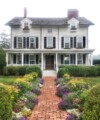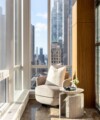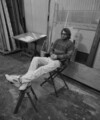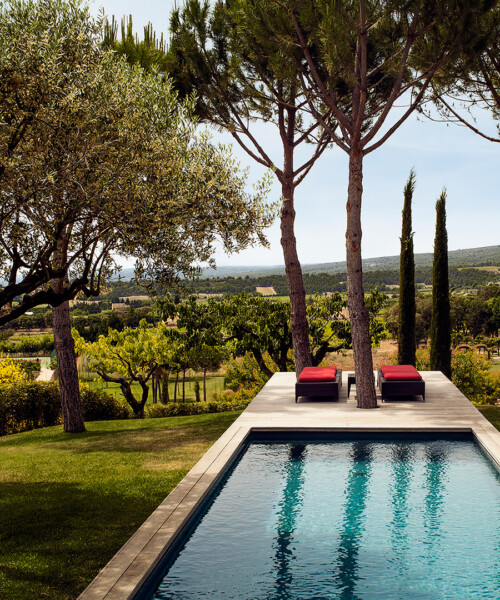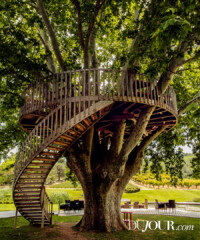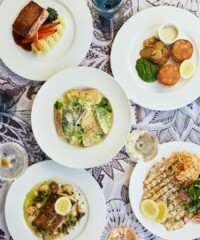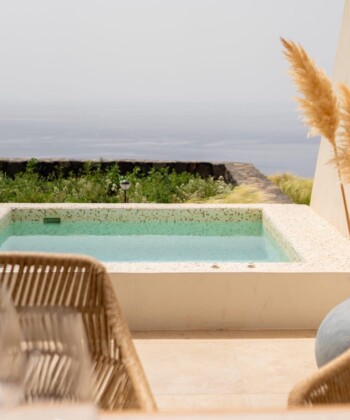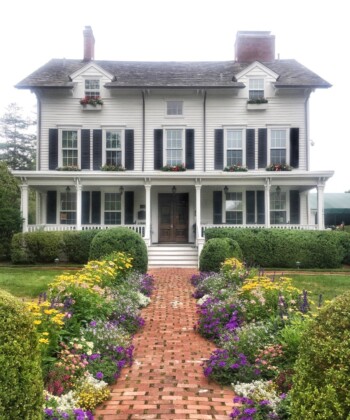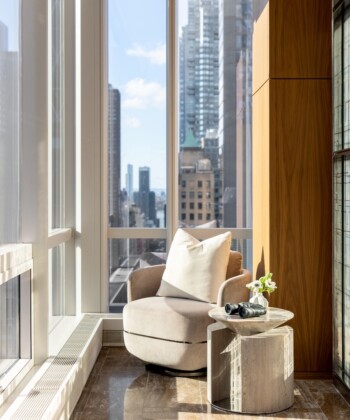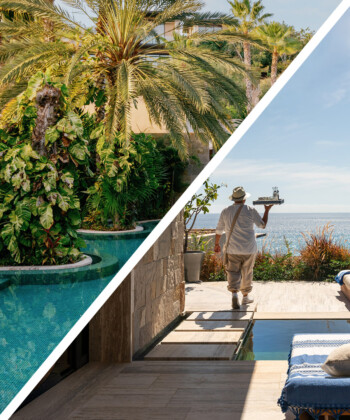In the charming Provençal region of The Luberon—where quaint villages and sweeping lavender fields are the main attraction—seclusion certainly isn’t hard to come by. It is perhaps most pronounced, though, within the confines of Domaine des Andéols, an 81-acre secluded haven just an hour’s drive east of Avignon. I’ve discovered this on the deck of Maison Rouge, one of the 10 isolated cottages that comprise the hilltop hamlet of Andéols. It’s a balmy afternoon in late spring, and I’ve just spent several hours lazing on a sun lounger that sits beside my private pool. There are birds tweeting, crickets chirping and uninterrupted views of the surrounding countryside. Inside the gates of Maison Rouge, I am in a world of my own.
It would be technically accurate to call Andéols a “hotel”—the property is open to guests seven months out of the year—but it is also an artist’s retreat and gallery, showcasing a collection of more than 250 works. “Every one of the Maisons is like a voyage. In each, we tried to create a unique universe,” explains owner Olivier Massart, a former photographer who now runs La Mode en Images, a hip Paris-based events company that has staged runway shows for clients like John Galliano and Jean Paul Gaultier. Massart and his wife, Patrizia, a former model, are avid art collectors—they designed each Maison around a distinct theme, which in most cases was inspired by a piece they already owned. The starting point of the tribal-themed Maison du Voyageur, for instance, was a series of masks from Ghana, Nigeria and the Congo. Today, it is also home to a stuffed Bengal tiger. The Maison Blanche (“White House”) is meant to evoke Greece; the Maison des Cascades (“House of Waterfalls”), Japan.
Andéols is no doubt a reflection of the Massarts, a family that has creativity in its bloodline. Olivier’s father, Jean, was the CEO of Christian Dior; his grandfather, Pierre, was a dentist and passionate artist who bought what still serves as the family’s private home there in 1918. Today, several of Pierre’s sculptures and mosaics are scattered around the grounds.
It was in the late 1990s that Olivier decided to acquire not only the other houses in the hamlet, but also an adjacent farm. “A lot of things were completely abandoned,” recalls Patrizia. Together, they set about restoring the buildings, and instead of creating simple rooms or suites, opted to propose a series of houses, or “Maisons.” The Massarts’ initial intent was twofold: to run the property as a hotel during the summer months and as a residence for artists during the winter. In time, however, they realized it was not financially feasible to keep it open year-round, so they set aside their cultural ambitions and now welcome guests from the first weekend of April to the end of October. Nevertheless, art is still very present. The Domaine regularly organizes exhibitions in collaboration with the cutting-edge Parisian gallery Kamel Mennour, and the Maisons are decorated with works by the likes of Andy Warhol, Ellen von Unwerth and David LaChapelle.
Indeed, while the exteriors of the stone and ochre stucco buildings are quintessentially Provençal, the decoration inside is in striking contrast. There is a whole host of flashy, bright colors and an impressive collection of both 20th century and contemporary design—Ron Arad and Isamu Noguchi sofas, René Herbst and Harry Bertoia chairs, Serge Mouille lights, a custom chandelier created in situ by Pucci de Rossi. It’s the quirky kind of place that attracts the fashionable and famous—among Andéols’ guests have been Hugh Jackman, Ridley Scott and Givenchy’s creative director Riccardo Tisci.
But you aren’t likely to bump into a celebrity guest—or any guest for that matter—considering the vastness of the property. Unless, of course, they are indulging beside you in the hotel’s treetop dining room, a wooden platform built 23 feet above ground into the branches of a majestic plane tree. It is here that I first meet Cesare, Olivier and Patrizia’s genial son, who helps manage the property. He explains over lunch that during World War II, his great-grandfather cared for patients at one of the springs by this very tree. (“The pure water was the best guarantee against infection,” he says.) Two generations later, guests can be found in the same spot, dining on fresh-caught sea bass prepared by Belgian chef Steve Deconinck. In former times, the Massarts ran the restaurant in partnership first with Alain Ducasse, and then Guy Martin of the Michelin-starred eatery Le Grand Véfour in Paris. Over the years, however, they have oriented the cuisine toward more simplicity. Chef Deconinck’s focus is placed firmly on the quality of the products, most of which are either sourced locally or come from the Domaine’s two vegetable gardens. There are 15 different types of basil, for example, and breakfast includes eggs laid by the Domaine’s own chickens, as well as artisanal jams from the neighboring village of Gargas.
The Luberon’s villages are unquestionably the region’s draw. Several are perched atop hills, the most popular being Gordes, with its Cistercian abbey, and Roussillon, famous for its pigments and ochres. Yet many visitors will be happy simply staying put at the Domaine, lounging by the pool or exploring the grounds. There is a Japanese garden with bamboo, rocks and gravel, a piece of Land Art in the form of a spiral hillock, several ponds and an enclosure housing not only goats and geese but also gypsy caravans formerly for staff. Olivier planted the slender cypress trees as a reminder of Patrizia’s native Italy. “He wanted to add a touch of Tuscany so she wouldn’t feel homesick,” says Cesare.
In the coming years, the Massarts are planning a number of other additions—a 2,200-square-foot spa for 2017 and 10 new suites, the first of which they hope will be ready for the 2016 season. Located downslope from the main swimming pool, the new suites will be outfitted with solar panels and extremely discreet. The plan is to embed them in the earth so they won’t alter the property’s physiognomy—an approach that aligns perfectly with the Domaine’s ethos. “Everything has always been thought out so that even when the hotel is full, guests still have the impression they’re on their own,” says Cesare. That sense of solitude is easily the best part.







